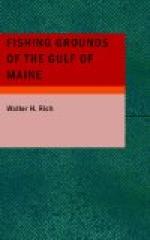Haddock, cod, cusk, halibut, pollock and hake are the principal food fishes procured from this bank, ranking in volume in the order named. In value, however, halibut takes third place in the list. Cod are plentiful here in winter, though fewer vessels fish here than on Georges Bank, at that season. At other seasons the codfishery on Browns Bank compares favorably with that of other banks in the vicinity. Cod are present the year around, in May and June feeding in depths of about 40 fathoms, going into 80 fathoms in August, and into depths of about 100 fathoms in cold weather.
Haddock, also, are present all the year, the period of greatest abundance being usually January and February. In March and April they are most abundant in 27 to 30 fathoms; at other seasons they are in 50 fathoms and deeper, especially in winter, when generally they can be found in 80 to 100 fathoms. Cusk are present in the deep water all the year.
Older reports say (1880-81): “Halibut were formerly found here in abundance, but at present the fishery is limited to an occasional trip off the southern and western edge.” It will be noted that a fair amount of halibut was taken here during 1923, when this bank ranked third in volume of halibut taken, which seems a good showing when the comparatively small size of the ground is considered. Fairly good catches have been made SW from the Northwest Peak of Browns, about 66 deg. 50’ west longitude and 42 deg. 40’ north latitude, along the 100-fathom curve and following eastward to the southward of La Have and beyond, perhaps to 63 deg. west longitude. The Southeast Peak is perhaps the most productive of the halibut grounds here, “setting” off from the shoaler parts into the narrow deep-water channel between this and Georges perhaps 20 miles distant.
A considerable part of the fish listed under the heading “Miscellaneous” are swordfish, which come upon this bank during their summer wanderings.
It will be noted that the number of otter-trawl fares from this ground is small. It is only in recent years that this method of fishing has been employed here, the bottom having been thought to be too rough for the successful operation of gear of this type upon it.
Seal Island Ground. This is called also on the charts in its northwest part, the German Bank and lies off the western part of Nova Scotia. Very few charts show it, as it is somewhat difficult to define its exact limits. It is a direct continuation of the shore soundings, which slope gradually from the land to the S. and W. and continue in a northerly direction beyond what might be considered the bounds of the grounds. To the S. it extends nearly to Browns Bank, from which it is separated by a narrow gully 70 to 80 fathoms deep. To the N. it reaches 38 miles beyond Seal Island and to the NW. about 35 miles from the same island. The southern limit of the ground is in 43 deg. and the northern 43 deg. 45’ north latitude, while the western boundary may be placed at 66 deg. 40’ west longitude. The entire ground outside the 3 mile limit covers an area of 1,250 miles.




